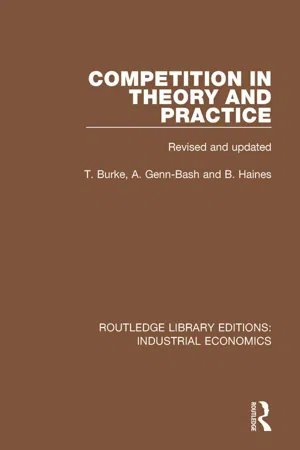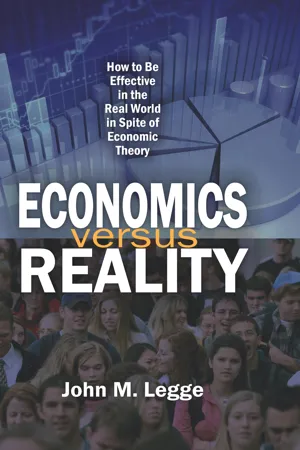Economics
Perfectly Competitive Firm
A perfectly competitive firm is a theoretical model in which firms are price takers, meaning they have no control over the market price and must accept the prevailing market price for their goods or services. In this model, firms are assumed to produce homogeneous products and have easy entry and exit from the market.
Written by Perlego with AI-assistance
Related key terms
7 Key excerpts on "Perfectly Competitive Firm"
- eBook - ePub
- Andrew Barkley, Paul W. Barkley(Authors)
- 2020(Publication Date)
- Routledge(Publisher)
- Market power is the ability of a firm to set price. Monopolists have complete market power; competitive firms have no market power.
- A Perfectly Competitive Firm has four characteristics: (1) numerous buyers and sellers, a homogeneous product, (3) freedom of entry and exit, and (4) perfect information.
- A price taker is a firm so small relative to the industry that it has no influence over price. A price maker has the ability to influence price.
- The demand curve facing an individual competitive firm is perfectly elastic.
- Profit maximization conditions for a competitive firm are MR = MC, and the MC cuts MR from below.
- Efficiency is a condition indicating that production of goods and services occurs at the lowest cost and consumers pay the lowest possible prices. Efficiency is consistent with all resources earning their opportunity costs.
- A competitive firm’s best strategy for maximizing profits is to minimize costs.
12.7 Chapter 12 glossary
Efficiency —A characteristic of competitive markets, indicating that goods and services are produced at the lowest possible cost and consumers pay the lowest possible prices.Market Power - eBook - ePub
- Andrew Barkley, Paul W. Barkley(Authors)
- 2016(Publication Date)
- Routledge(Publisher)
An example of an industry protected by barriers to entry is the electricity market in the Northwest US. Pacific Power, a division of PacificCorp, has the legal right to produce and sell electricity in many parts of California, Oregon, and Washington. In 2012, it provided electrical power to nearly one million residential and commercial customers. No other firm can lawfully enter the market and sell electricity in areas served by Pacific Power. Other firms and industries may have the technical knowledge, economic knowledge, and the generating capacity to sell electricity in Pacific Power’s area. They cannot because they lack the freedom of entry requirement to become part of a competitive industry in the region. Walmart and other big box stores such as Target or BestBuy attempt to locate in many areas, but local governments often do not allow these stores the legal right to enter the local market. These are examples of barriers to entry into an industry. Competitive firms can enter and exit at will: think of the restaurant business in New York City, or of corn producers in Nebraska.The four characteristics of a perfectly competitive industry form the basis for models of competitive firms and industries. This modeling helps analysts understand how firms behave, how they use specialized resources, and how managers of firms in competitive settings can increase their profitability.12.3 The Perfectly Competitive Firm
Each firm in a perfectly competitive market is a Price Taker that can exert no influence over output prices. For example, the wheat seller takes whatever price the buyer offers.- Price Taker = a firm so small relative to the industry that the output price is fixed and given, no matter how large or how small the quantity of output it sells.
A price taker is a firm that has no market power. It must take input and output prices as given and fixed. Even though competitive firms exert no influence on product prices, the prices themselves fluctuate in response to forces outside the firms’ control.Firms that have market power are Price Makers. These firms have at least some ability to influence the price of outputs because of the large size of the firm relative to the market. They produce and sell enough product to affect the price of the good.- Price Maker = a firm characterized by market power, or the ability to influence the price of its output. A firm facing a downward-sloping demand curve.
Restated, a price maker is a firm that faces a downward-sloping demand curve. These price maker firms are the subject of Chapter 13 .12.3.1 The demand curve facing a competitive firm
A competitive firm is small relative to the industry, so small that it cannot influence the price of the product that it sells. Consider an individual rice producer in Jackson County, Arkansas. Figure 12.1 shows the relationship between the rice market, on the left, and the individual rice producer, on the right. The interaction of all (aggregated) rice producers and consumers appears in the supply and demand curves on the left. Market forces establish an equilibrium price at the intersection of supply (Qs ) and demand (Qd ). In equilibrium, a quantity of Q* billion cwt of rice is produced and sold at a price of P* dollars per hundredweight (cwt). The demand curve slopes downward due to the law of demand and the supply curve slopes upward due to the law of supply (Chapter 8 - eBook - ePub
Microeconomics
A Global Text
- Judy Whitehead(Author)
- 2014(Publication Date)
- Routledge(Publisher)
9 The Perfectly Competitive MarketEquilibrium of the Firm and Industry in Short-run and Long-run ; Perfect Competition and Economic Efficiency ; Industry Dynamics: Changes in Demand, Costs and Taxes .The market structure of Perfect Competition is often considered a highly desirable one particularly from the point of view of economic efficiency in a static, distributive sense. This is in consonance with the view that trading in increasingly competitive markets is, in theory, beneficial to economic welfare because of the greater efficiency in the use of economic resources. While this may or may not hold true in reality, it is nevertheless of importance to understand the intricacies and mechanics of this model which has received so much attention.Perfect Competition is the centrepiece of the traditional theory of the firm. It is one of the four basic models of market structure that make up the traditional theory of the firm. The others are Monopoly, Monopolistic Competition and Oligopoly. As a model of market structure, it is used to explain and predict the behaviour of firms which are part of this industry. Furthermore, as one of the so-called ‘marginalist’ models of the firm, the firm is theorized to maximize profits by following the ‘marginalist’ rule of equating marginal revenue with marginal cost.These marginalist models are later contrasted with the more modern alternative models of the firm which are included in the study of market structure. Newer models have proliferated since the 1930 and particularly since the 1950s and include the Managerial, Behavioural, Average-cost/Mark-up Pricing and Entry-Prevention models.9.1 Assumptions and Fundamentals of the Model
9.1.1 Basic assumptions
The basic assumptions of the model of Perfect Competition are as follows:- There are many buyers and sellers (firms) in the industry. There are so many buyers and sellers that no single buyer or seller can influence price or output sufficiently to alter the equilibrium of the industry.
- eBook - ePub
- Terry Burke, Angela Genn-Bash, Brian Haines(Authors)
- 2018(Publication Date)
- Routledge(Publisher)
The polar cases of monopoly and perfect competition tend to receive most coverage in the literature. Welfare economics suggests to us that competition is ‘good’ and monopoly is ‘bad’. In particular we are told that perfect competition can result in an optimal distribution of resources in society. Let us consider the four different types of markets that firms can operate in.Perfect competitionA perfectly competitive market can be viewed as some sort of theoretical construct that doesn’t exist in the real world. However, the only sector of the economy that gets close to perfectly competitive markets is probably agriculture. Many farms are price takers and produce only a tiny fraction of the total supply of eggs, milk, etc., for which there are many buyers. The product sold in an agricultural market is often homogeneous in character and entry barriers are minimal. Also profit maximisation would seem to be a sensible, and probably necessary, objective if a small farm is to survive.Ritson (1977, p. 121) has summarised the nature of a perfectly competitive market by giving the following set of five conditions required to attain it: 1. There are many buyers and sellers such that the action of no one individual buyer or seller can have a perceptible influence upon market price. 2. Producers and consumers have perfect knowledge of events in the market and act on this knowledge. 3. The product is homogeneous so that customers are indifferent between the produce of alternative suppliers. 4. Firms act independently of each other in such a way as to maximise their individual profits and each consumer acts similarly so as to maximise utility from consumption.5. There are no barriers to the movement of goods or factors of production. Firms are therefore free to enter or leave the production of the product and are able to supply to the market whatever quantity they wish. - eBook - ePub
Economic Principles and Problems
A Pluralist Introduction
- Geoffrey Schneider(Author)
- 2021(Publication Date)
- Routledge(Publisher)
P to fall.Passage contains an image
14 Perfect competition and competitive marketsThe perfect, Smithian market structure
DOI: 10.4324/9781315636924-18This chapter develops the mainstream model of profit maximization in perfectly competitive industries. This perfect market structure needs little or no regulation due to the degree of competition. Recall that Adam Smith advocated laissez-faire capitalism if markets were truly competitive, whereas Smith was very critical of markets that were controlled by huge industries, especially when they operated with the complicity and assistance of government officials.In theory, firms operating in perfectly competitive markets provide exactly the amount and quality of goods consumers want at the lowest possible price. If firms do not do this, their competition puts them out of the market. Firms do not bother with advertising in perfectly competitive markets—it is too costly, and it comes with no significant benefits because all products are identical and it is impossible to establish product differentiation. Instead, firms focus on providing the best product at the best price. Workers also benefit from perfectly competitive markets because dozens of small firms are bidding for their services. It seems like the perfect form of the market system. In fact, some economists are so taken with perfectly competitive market structures that they think the goal of government regulators should be to try to make all markets function like perfectly competitive ones.But there is a dark side even to competitive markets. The same forces that require firms to produce at the lowest cost possible to stay competitive also encourage firms to ignore environmental laws and worker safety regulations. If some competitors gain a cost advantage by being unscrupulous, other firms must imitate their behavior in order to survive. Thus, even in perfectly competitive markets there is some need for regulation to prevent a race to the bottom. - eBook - ePub
Microeconomic Foundations I
Choice and Competitive Markets
- David Kreps(Author)
- 2012(Publication Date)
- Princeton University Press(Publisher)
Chapter NineCompetitive andProfit-Maximizing Firms
Two categories of entities inhabit neoclassical microeconomic theory, consumers and firms. We’ve met consumers at length already, with more to come in Chapters 10 and 11 . The story about firms is shorter and simpler; it can be contained within a single albeit lengthy chapter.In neoclassical economics, firms are optimizing entities, similar to consumers. In more recent developments, firms are analyzed as institutions, within which individual optimizing agents (investors, managers, employees, and so forth) interact. In this volume and, in particular, in this chapter, we explore the neoclassical theory only, treating firms as entities.Also, we will restrict our attention to the special case of a competitive (or price-taking), profit-maximizing firm. A large portion of the neoclassical theory of the firm concerns firms with the power to affect prices, in the so-called theories of monopoly, oligopoly, and monopolistic competition. Consumers, with the exception of people such as Bill Gates, are naturally thought of as being so small relative to the markets in which they participate, that their actions do not materially affect the prices they face; for firms, this assumption is certainly much less natural. Yet we will study only competitive firms and, moreover, firms that face linear prices for their inputs and outputs. For reasons to be discussed, we will study firms with a single objective function: maximization of profit. And we will restrict attention to the “static” theory of the firm: Firms, we will see momentarily, are entities that transform bundles of commodities into different bundles of commodities via production; we will deal only with instantaneous production, in which inputs are purchased, transformed, and sold in an instant of time.1 - eBook - ePub
Economics versus Reality
How to be Effective in the Real World in Spite of Economic Theory
- John M Legge(Author)
- 2017(Publication Date)
- Routledge(Publisher)
22 suggest that if there is an oligopoly with more than four members, competition, possibly including price competition, will force the weaker members into mergers or bankruptcy until there are only three large firms (with a market share of over 15 percent) left. Small firms, with a market share of less than 5 percent, can survive in such a market under the price umbrella set by the larger firms by specializing in market niches; but firms with a market share between 5 and 15 percent struggle to survive.A number of well-regarded economists have developed explanations for the prevalence of competitive imperfection. There has been little if any attempt made by the economically orthodox to refute these explanations; rather, the leading academic journals and economics departments simply ignore them and persist in the assumption that real competition may be treated as if it were perfect, or at least that papers and arguments that implicitly assume the prevalence of perfect competition may be treated as both descriptive of the real world and the basis of policy advice to governments.23The business historian A. D. Chandler (1915–2007) and the economist Edith Penrose (1914–1996) are associated with a small “realist” school of economics; but while their work is a crucial part of the foundations of modern management theory, it has little recognition among the generality of academic economists.Monopolistic Competition
When consumers can differentiate between suppliers and form preferences, the basic conditions for perfect competition are breached. When there are numerous suppliers offering products that are at least partial substitutes the industry cannot be fairly described as an oligopoly. The law in most jurisdictions specifically grants every firm an exclusive right to its own name, and in general these rights are extended to a firm’s brands and trademarks. Even without the use of brands and trademarks, firms necessarily operate from different premises, and consumers will face different travel costs if they patronize different suppliers.One of Chamberlin’s more easily appreciated models of monopolistic competition was spatial. Gasoline retailing is a good example of monopolistic competition: there are usually several miles between gasoline stations on any road, so a decision to pass one gasoline retailer and stop at the next involves some time and operating costs. Even if a distant gasoline retailer offered slightly cheaper fuel, a motorist who drove out of his way to travel to it would be worse off if the cost of traveling the extra distance was greater than the saving in the price.
Learn about this page
Index pages curate the most relevant extracts from our library of academic textbooks. They’ve been created using an in-house natural language model (NLM), each adding context and meaning to key research topics.






